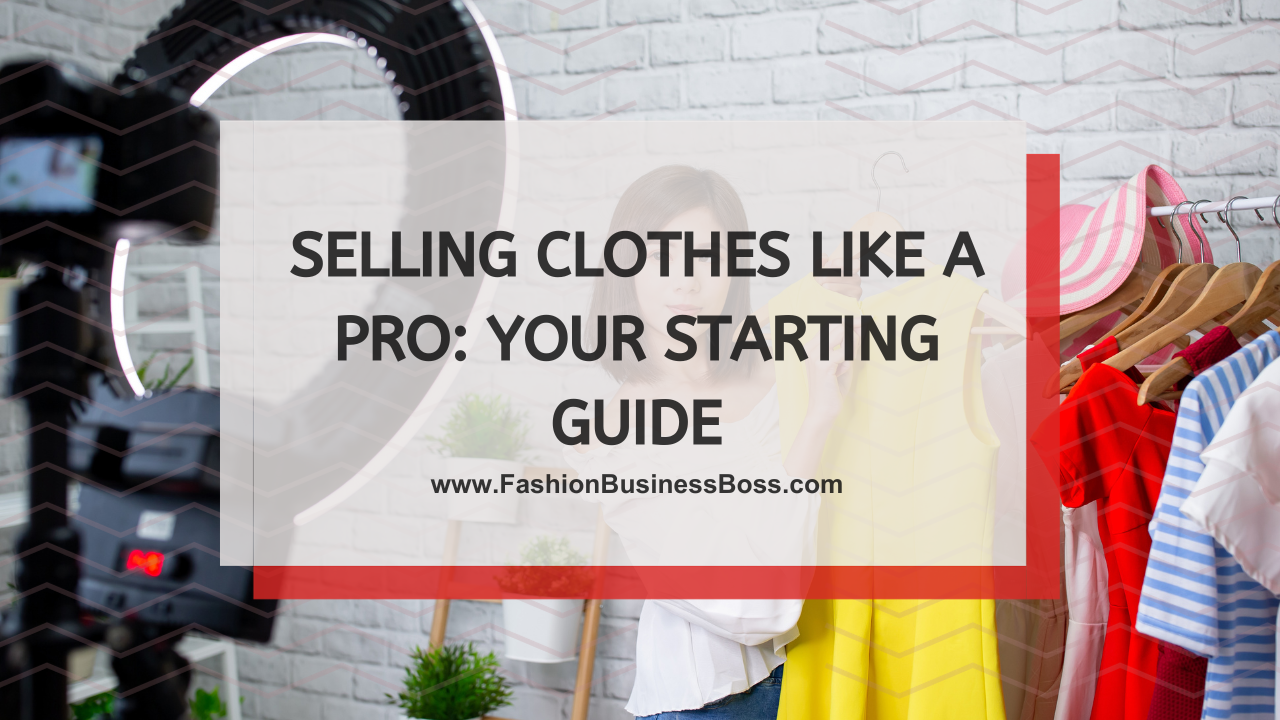Are you passionate about fashion? Do you have a closet overflowing with clothes that you no longer wear? It’s time to turn that passion into profit by venturing into the world of selling clothes.
To start selling clothes, find your niche, source inventory smartly, and create a strong online presence. Offer great customer service and continuously learn about fashion trends.
In this article, we will walk you through the essential steps to get started and succeed in the clothing resale business.
Find Your Niche

It’s essential to pinpoint your area of expertise and interest before embarking on your clothing resale venture. This means determining the specific type of clothing you’re most familiar with and enthusiastic about selling.
Are you drawn to vintage clothing with its timeless charm, or do you have a knack for recognizing designer brands? Perhaps your passion lies in everyday casual wear that appeals to a wide audience. Your niche represents the clothing category you know well and feel strongly about.
Identifying your niche is vital for a few reasons. First, it allows you to focus your efforts on a particular segment of the market, which can be more manageable than trying to cater to everyone. Second, it helps you find your target audience—the people most likely to be interested in the kind of clothing you offer. Having a clear niche sets you apart in the competitive world of clothing resale, making your business more memorable to potential customers.
Read more about: How to Have Your Own Clothing Brand: Tailoring Your Brand Identity
Source Your Inventory
After determining your niche in the clothing resale business, the next step is acquiring the items you intend to sell. There are four primary methods to source your inventory:
Begin by thoroughly assessing your own wardrobe. Identify clothing items that you no longer wear but are still in good condition. These pieces can serve as your initial inventory without incurring additional expenses.
Thrift stores can be a valuable resource for discovering unique and budget-friendly clothing items. Search for well-maintained pieces that align with your chosen niche and personal style. Thrifting can be cost-effective and environmentally conscious.
If your goal is to offer new clothing items, consider purchasing from wholesalers or manufacturers. This approach provides a consistent supply of brand-new apparel for your inventory.
Another option is to collaborate with individuals who wish to sell their clothes through your platform. In this arrangement, you share the profits with the clothing owners while offering them a platform to reach potential buyers.
Create an Online Presence
Establishing a presence on the internet is essential in today’s digital era. Here’s a straightforward guide on what you should do:
To begin, you must decide where you’d like to sell your clothing. You have a few options:
- You can create your own website, providing you with full control over your online store.
- Alternatively, you can opt for established e-commerce platforms like Shopify or Etsy, which simplify the setup process.
- Utilizing social media platforms such as Instagram and Facebook is also an option. These platforms can serve as an initial storefront to showcase your items.
Invest in decent lighting and a camera with a good resolution. This will enable you to capture attractive, clear images of your clothing items. High-quality photos make your products more appealing to potential buyers.
Craft detailed and engaging descriptions for each clothing item you list. Highlight essential information like key features, materials used, and sizing details. Clear, informative descriptions help buyers make informed decisions.
Determine your pricing strategy. Take into account factors like the brand, the condition of the clothing, and the uniqueness of each item. Ensure that your prices align with the value you offer.
Marketing and Promotion

Once your online clothing store is set up, it’s crucial to draw customers in through marketing and promotion. Here are some practical strategies to achieve this:
Utilize popular platforms like Instagram, Facebook, and Pinterest to display your clothing items. Share appealing photos and interact with your audience. By doing so, you can create a buzz around your store and engage potential customers.
Build an email list of interested customers and send out newsletters regularly. These emails can include promotions, announcements of new arrivals, and style tips. It’s a way to keep your audience informed and engaged.
Partner with fashion influencers or bloggers who align with your niche. They can promote your clothing through shoutouts and reviews, introducing your store to a broader audience.
Optimize your product listings and website for search engines. Use relevant keywords in your product descriptions and titles. When your store appears in search results, it enhances your online visibility and attracts organic traffic.
Read more about: How to Make a Clothing Business Thrive: Rise to the Top
Provide Excellent Customer Service
Providing excellent customer service is essential for the longevity of your clothing resale business. Here’s how you can achieve this:
It’s crucial to address customer inquiries and messages in a timely and polite manner. Swift responses show that you value your customers and their questions.
Offer clear and transparent information regarding your shipping policies. Ensure that customers know what to expect in terms of delivery times and costs. Make the returns process hassle-free and straightforward. A clear returns policy can build trust with your customers.
Encourage your customers to share their thoughts and experiences. Positive or constructive feedback helps you understand your customers’ needs better and allows you to make improvements. Furthermore, customer reviews can help establish trust with potential buyers.
By consistently providing courteous and efficient customer service, you create a positive shopping experience for your customers. This, in turn, fosters loyalty and encourages repeat business. Customer satisfaction is an integral part of sustaining and growing your clothing resale venture.
Stay Updated
Staying current with fashion trends and consumer preferences is vital in the clothing resale business. Here’s how you can stay updated:
One effective way to stay in the loop is by attending fashion events and shows. These events showcase the latest styles and emerging trends. By being present at such gatherings, you gain firsthand knowledge of what’s hot in the fashion world.
Keeping an eye on industry news, both online and offline, is another essential practice. Fashion magazines, websites, and social media platforms often provide updates on new trends, designers, and consumer preferences. This information helps you make informed decisions about which clothing items to stock.
Observing what your competitors are doing is a valuable strategy. Take note of the types of clothing they offer, their pricing strategies, and their marketing tactics. This insight can guide your own business decisions and help you stand out in the market.
Scale Your Business

When your clothing resale business experiences growth, it’s essential to consider scaling it to accommodate the increased demand. Here are some straightforward steps for scaling your business:
Broaden your inventory by adding new clothing items or categories that align with your niche and customer preferences. Offering a more extensive selection can attract a wider range of customers.
If the workload becomes overwhelming, it may be time to consider hiring additional staff. Extra hands can help with tasks such as inventory management, customer service, and marketing.
Look into new marketing channels and strategies to expand your reach. This might involve advertising on different social media platforms, collaborating with more influencers, or exploring paid advertising options.
If it aligns with your business goals and resources, you could consider opening a physical store or pop-up shop. A physical presence can attract local customers and provide a unique shopping experience.
Read more about: Launching Your Dream Store: The Costs of Online Clothing Retail
Build Trust and Reputation
Establishing trust and building a strong reputation is fundamental in the clothing resale business. Here’s how you can do it:
Ensuring the authenticity of any designer or high-end clothing items you sell is crucial. Buyers value honesty and transparency. Be clear about the origin and authenticity of your products to build trust.
Encourage satisfied customers to share their experiences by leaving positive reviews and testimonials on your website or chosen platform. Genuine feedback from happy customers can help establish credibility.
Utilize reputable and secure payment processing systems for your transactions. This ensures the safety of both you and your customers’ financial information. Trustworthy payment methods contribute to a sense of security.
Building trust and a solid reputation takes time, but it’s worth the effort. It helps foster loyalty among your customers, encourages repeat business, and attracts new buyers. By prioritizing authenticity, encouraging positive feedback, and ensuring secure transactions, you create a trustworthy environment for your clothing resale business to thrive.
Inventory Management
Effective inventory management is essential to ensure the smooth operation of your clothing resale business. Here’s how you can do it:
Implement an organized system for managing your inventory. Categorize items by type, size, and season. This makes it easier to locate and display clothing items, improving the overall shopping experience for your customers.
Consider utilizing inventory management software. These tools help you keep track of your stock levels, monitor sales, and set reorder points for items running low. Inventory software can streamline the process and reduce the risk of overstocking or understocking.
Rotate your inventory seasonally to showcase relevant clothing items. This practice ensures that your offerings align with the current season, making it more likely for customers to find what they need. It also helps clear out older stock, preventing items from becoming outdated.
Efficient inventory management allows you to optimize your resources, minimize waste, and provide a better shopping experience for your customers. By implementing these practices, you can maintain control over your inventory and keep your clothing resale business running smoothly.
Legal and Tax Considerations

It’s vital not to disregard the legal and tax considerations when operating your clothing resale business. Here’s a straightforward guide:
Firstly, determine the legal structure for your business. You can choose from options like sole proprietorship, limited liability company (LLC), or corporation. After deciding, register your business accordingly with the appropriate authorities.
Understanding your tax obligations is crucial. You’ll likely need to deal with various taxes, including sales tax and income tax. Familiarize yourself with the tax laws and regulations in your area, and make sure to comply with them.
It’s essential to check whether your local jurisdiction requires specific permits or licenses for your type of business. These permits ensure that you’re operating legally within your locality and help avoid any potential legal issues.
By addressing these legal and tax considerations, you ensure that your clothing resale business operates within the boundaries of the law. This not only protects you from potential legal problems but also establishes a solid foundation for your business to thrive.
Read more about: Launching Your Brand: A Clothing Line Starter Kit
Conclusion
Remember, growth in the clothing resale business takes time and dedication. Keep learning, adapt to changes in the market, and most importantly, enjoy the journey of turning your passion into an effective venture.
Frequently Asked Questions

Q: How can one choose an appropriate niche for a clothing resale business?
A: Selecting the right niche involves assessing knowledge, considering market demand, and evaluating competition.
Q: Where can clothing inventory for resale be sourced?
A: Inventory can be obtained from various sources such as personal closets, thrift stores, wholesalers, or through consignment arrangements.
Q: What are effective marketing strategies for a clothing business?
A: Effective marketing includes utilizing social media, email campaigns, collaborations with influencers, and optimizing websites for search engines.
Q: How can customer satisfaction and trust be ensured in a clothing resale business?
A: Building trust necessitates offering authentic products, delivering prompt customer service, maintaining transparent policies, and encouraging positive reviews.
Q: What legal and tax considerations should be kept in mind when selling clothes?
A: Legal considerations include business structure, tax compliance, and obtaining necessary permits and licenses in the respective locality.
To learn more about starting your own clothing business, check out my startup documents here.
Please note that the contents of this blog are for informational and entertainment purposes only and should not be construed as legal advice. Any action taken based on the information provided in this blog is solely at your own risk. Additionally, all images used in this blog are generated under the CC0 license of Creative Commons, which means they are free to use for any purpose without attribution.

Meet Shawn Chun: Entrepreneur and Fashion Business Fan.
I’m a happy individual who happens to be an entrepreneur. I have owned several types of businesses in my life from a coffee shop to an import and export business to an online review business plus a few more and now I create online resources for those interested in starting new ventures. It’s demanding work but I love it. I do it for those passionate about their business and their goals. That’s why when I meet a designer or boutique owner at a craft fair, farmers market, retail location or anywhere else I see myself. I know how hard the struggle is to retain clients, find good employees and keep the business growing all while trying to stay competitive.
That’s why I created Fashion Business Boss: I want to help fashion business owners like you build a thriving business that brings you endless joy and supports your ideal lifestyle.

